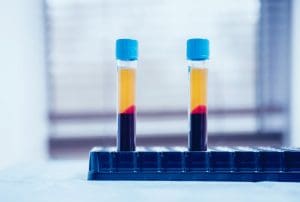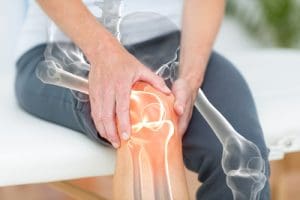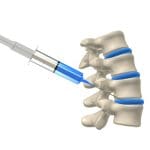
For Managing Chronic Pain
Comprehensive Physical Medicine & Rehabilitation
Our physiatrists offer a variety of diagnostic and non-operative pain management options, including ultrasound-guided injections, orthobiologics, nerve block and acupuncture. These may be prescribed in combination or alone. Our physicians also work in partnership with local physical therapists and other professionals to offer comprehensive pain management treatment.
Injections, Electrodiagnosis & Radiofrequency Ablation
Diagnosing & Managing Chronic Pain

Non-Surgical Treatment Options
Musculoskeletal degeneration and complications from injuries have become more prevalent as people live longer and increasingly participate in more rigorous athletic and recreational activities. At the Center for Spine and Orthopedics, we strive to offer our patients a wide array of non-surgical treatment options, including orthobiologics, such as platelet injection therapy. Platelet injections have been around since the mid 1990’s and is the most common type of orthobiologics as well as the most studied.
What is orthobiologics?
Orthobiologics refers to the use of the body’s repair cells or platelet injections to repair and heal damaged tissues. The body’s repair cells occur naturally in bone marrow and fat tissue and can be harvested from your own living cells or from someone else’s cells in the case of placental embryonic cells (typically a pregnant mother’s cord blood following child birth).
The body’s repair cells are most commonly harvested from a patient’s bone marrow or fat, both of which require a surgery center and anesthesia. The use of the body’s repair cells harvested from placental tissue involves an in-office procedure not requiring a surgery center or anesthesia. Platelet injections involve an approximately 30-minute in-office procedure without anesthesia.
What types of orthobiologics are offered at CSO?
Our board-certified pain management specialists offer platelet injections for hip, knee, foot and ankle, hand, and shoulder joints and the facets of the cervical (neck) and lumbar (lower back) spine.
Why CSO for orthobiologics?
The key to effectively administering orthobiologics injections is the placement of the injection at the exact point of injury. Our specialists, Dr. George Leimbach and Dr. Paul Leo, each have 30 years of experience giving injections, and they have a 99 percent track record of success. To ensure that platelet injections get to the exact injury site, they administer platelets very precisely, using image guidance with ultrasound or, in the case of disc pain, with fluoroscopy.
Shockwave Therapy is another technique offered to patients to deal with pain. It is a newer treatment method and can promote quicker recovery from exercise, injury or surgery. Click here to learn more!
Is orthobiologics covered by most insurance?
Platelet injections and other forms of orthobiologics are covered by Workers Compensation and Personal Injury. They are not usually covered by most insurance.
What is the cost of platelet injections?
The cost of platelet injections can run up to $2,500 out-of-pocket. However, at CSO, we have our own in-office equipment and can offer a very high quality service in a single office visit for $750 per injection.
Unlike many centers offering only orthobiologics, we offer multi-modal non-operative treatment. Therefore, our practice is not solely dependent upon orthobiologics as our sole source of income.
Our physiatrists offer a variety of diagnostic and non-operative pain management options to offer comprehensive pain management treatment.
 Often Effective After Only ONE Injection
Often Effective After Only ONE Injection
Platelet injections therapy is now used to treat a variety of musculoskeletal injuries. The process involves separating your body’s own natural healing cells, the platelets, from a sample of your blood via centrifugation, and then combining the increased concentration of platelets with the remaining blood and injecting them back into the body at the injury site. This induces a naturally occurring healing response.
Platelets are kind of like a group of construction workers. When a tear or cut in tissue occurs, the platelets work to create a scaffold, bringing those tissues back together and creating collagen and scar tissue to heal the torn and damaged tissue. Additionally, they release a variety of growth factors and anti-inflammatory cytokines to help induce this healing response and fix the painful problem.
Unlike traditional anti-inflammatory medications, which merely mask the symptoms, platelet injections offers the opportunity for real healing to occur and problems to be fixed.
What types of conditions are being treated successfully with platelet injections?
Tendon, ligament and joint injuries are the most common conditions that are being successfully treated with platelet injections, particularly tennis elbow, plantar fasciitis, knee osteoarthritis (mild or moderate) and rotator cuff tears. Additionally, there is evidence to support platelet injections’s use in back pain caused by a torn disc. At CSO, we have successfully treated patients with shoulder, neck and back pain with platelet injections.
“With platelet injections, my neck pain went from level 8 or 9 down to 2 within three days after my platelet injections injection.”
—Glenn McKnight, platelet injections Patient
Are platelet injections effective?
Research regarding platelet injections’s effectiveness shows a wide variety of findings. Factors that influence its effectiveness include:
- A patient’s overall health
- The area of the body being treated
- The quality of the injection
- And placement of the injection at the exact place of injury
At the Center for Spine and Orthopedics, our board-certified specialists with more than 30 years of experience administer platelet injections very precisely using image guidance with an ultrasound or, in the case of disc pain, with fluoroscopy to ensure that the platelet injections gets to the exact site of injury.
Typically, only one platelet injections injection is necessary to be effective. Occasionally, booster shots are required, often depending on whether you re-injure your tissue. It is kind of like fixing a flat tire on your bike. You may be able to fix it and ride another 5,000 miles or you might run over another nail and need another repair.
Generally, it can take up to six or eight weeks to know how effective a single platelet injections injection has been. The length of time varies depending how quickly an individual heals.
Our specialists recommend platelet injections as an option when discussing nearly any musculoskeletal pain complaint with their patients, particularly when traditional treatment options have failed or are otherwise not indicated.
CSO Patient Stories
 Preventative Relief & Pain Management
Preventative Relief & Pain Management
iovera° is a handheld device that provides targeted, long-lasting pain relief through cryoneurolysis. Cryoneurolysis is the freezing of the signal-carrying parts of a nerve.
The iovera° system creates a “cold zone” that blocks nerve signals and immediately reduces pain without the use of drugs and without permanently damaging nerves.
Many patients can benefit from the long-lasting pain relief of iovera° such as those experiencing pain in the knees, hips, shoulders, ribs, feet and more.
Click here to learn more about this non-surgical pain treatment option and determine if you’d be a good candidate.
 EPAT Extracorporeal Pulse Activation Technology
EPAT Extracorporeal Pulse Activation Technology
Shockwave therapy combines the physical properties of sonic pressure waves with medical science to produce a therapeutic result. It works by transforming continuous sound waves into short pressure pulses that flow through a targeted tissue to generate pain relief, plaque destruction and elasticity restoration without the need of drugs or invasive surgical procedures.
Shockwave is a relatively new treatment for various conditions affecting the muscles and tendons. The pulsating pressure emitted during the therapy works to break up and disperse scar tissue and increase blood flow, which helps to reduce pain and inflammation. Shockwave can also be used to promote quicker recovery from exercise, injury or surgery. It has a very safe track record that leaves no long-term side effects so a patient can benefit from a fast treatment that works both on short term and long-term injury healing.
Programmed Therapy Protocols for the following:
- tendonitis
- Achilles tendonitis
- Post muscular injury
- Post ligament injury
- Patellar tendinopathy
- Achillodynia
- Plantar fasciitis
- Heel spurs
- Periostitis / Shin splints
- Post surgical healing
 Part of a Comprehensive Treatment Plan
Part of a Comprehensive Treatment Plan
While spinal injections can be used to diagnose the source of back, leg, neck or arm pain, they are most often performed as part of a comprehensive treatment program, which usually includes an exercise program to improve or maintain spinal mobility and stability. Spinal injections are performed under x-ray guidance (fluoroscopy) to confirm correct medication placement and improve safety.
CSO Patient Stories
What are the most common types of injections available?
- Epidural injections
- Facet joint injections
- Sacroiliac joint injections
What are epidural injections used to treat?
Epidural injections are used to treat pain that starts in the spine and radiates to an arm or leg. Arm or leg pain often occur when a nerve is inflamed or compressed (pinched nerve).
Epidural injections involve injecting an anesthetic and an anti-inflammatory medication, such as a steroid (cortisone), near the affected nerve. This reduces inflammation and lessens or resolves the pain. This type of epidural injection is a therapeutic one.
For diagnostic purposes, an epidural spinal injection can be done at a very specific, isolated nerve site to determine if that particular nerve is the pain source. Sometimes only an anesthetic is injected. The immediate response to the injection is closely monitored. If the pain is completely or nearly completely relieved, then that specific nerve is the primary cause of the pain symptoms. If there is little pain relief, then another source of pain exists.
What are facet joint injections used to treat?
Facet joint injections can be done for diagnostic and therapeutic reasons and are often used when pain is caused by degenerative/arthritic conditions or injury. They are generally used to treat neck, middle back or lower back pain. The pain does not have to be exclusively limited to the midline spine as these problems can cause pain to radiate into the shoulders, buttocks or upper legs.
For diagnostic purposes, facet joints can be injected with an anesthetic directly into the joint or by anesthetizing the nerves carrying the pain signals away from the joint (medial branches of the nerve). If the majority of pain is relieved with anesthetic into the joint, then a therapeutic steroid injection may provide lasting neck or low back pain relief.
If anesthetic injections indicate that the nerve is the source of pain, the next step is to block the pain signals more permanently. This is done with radio frequency ablation (damaging the nerves that supply the joint with a “burning” technique).
How are sacroiliac joint injections used?
The SI joints are located between the sacrum and ilium (pelvic) bones. Problems in the SI joints have been shown to cause pain in the low back, buttock and leg. Typically, one joint is painful and causes pain on one side of the lower body. Less often, both SI joints are painful at the same time.
Similar to facet joint injections, the sacroiliac (SI) joint can also be injected for diagnostic and therapeutic purposes. Anesthetizing the SI joint by injection under x-ray guidance is considered the gold standard for diagnosing SI joint pain. A diagnostic injection of the sacroiliac joint with anesthetic should markedly diminish the amount of pain in a specific location of the low back, buttock or upper leg.
A therapeutic injection usually includes a steroid medication with the goal of providing longer pain relief.
When should spinal injections be avoided?
Some people are not good candidates for spinal injections, including people with:
- Skin infection at the site of needle puncture
- Bleeding disorder or anticoagulation
- Uncontrolled high blood pressure or diabetes
- An allergy to contrast, anesthetics or steroids
More information (http://orthoinfo.aaos.org/topic.cfm?topic=A00560)






